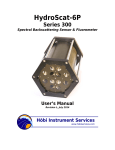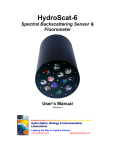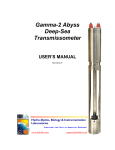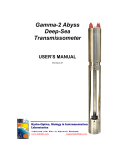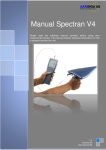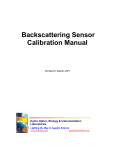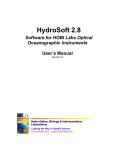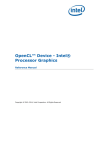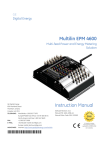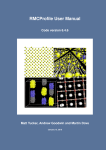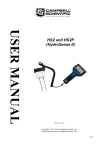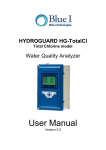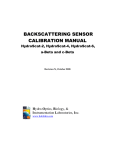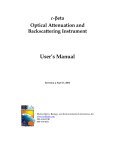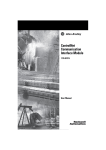Download HydroScat-2 User`s Manual - Institute of Marine and Coastal Sciences
Transcript
+\GUR6FDW6SHFWUDO
%DFNVFDWWHULQJ6HQVRU
USER’S MANUAL
Hydro-Optics, Biology, and Instrumentation Laboratories, Inc.
P.O Box 859, Moss Landing, CA 95039 USA
www.hobilabs.com
888-414-HOBI
888-414-4624
Revision date: May 20, 2002
Current Firmware Version: 1.84
Other firmware versions may differ in some respects. Contact HOBI Labs for
information on how to upgrade HydroScat firmware.
Revisions
May 20, 2002: Revise Shutter command (section 10) and include more references
to shutter throughout; add oil-encapsulated depth sensor (2.4); add note about
preserving data in case of reset (section 12); add to discussion of magnetic switch
behavior (section 5.9); update calculation of bb and add description of
Backscattering Parameters in HydroSoft (9.5) recommend minimum start delay
and warm-up time of 3 seconds; grammatical and format corrections.
February 20, 2002: Update addresses, contact information
June 15, 2001: Add anti-fouling shutter (section 10 and elsewhere).
February 16, 2001: Start of revision tracking. Extensive reorganization, changes
to incorporate HydroSoft, separate HydroScat-2 from HydroScat-6.
ii
TABLE OF CONTENTS
1.
INTRODUCTION ................................................................................................................................ 1
1.1.
1.2.
1.3.
1.4.
2.
PRECAUTIONS AND MAINTENANCE .......................................................................................... 5
2.1.
2.2.
2.3.
2.4.
2.5.
2.6.
3.
SETUP ........................................................................................................................................... 9
COLLECTING DATA....................................................................................................................... 9
DOWNLOADING DATA FROM THE HYDROSCAT .......................................................................... 10
DISCONNECTING ......................................................................................................................... 10
SWITCH-ACTIVATED LOGGING (SEE ALSO SECTION 5.9)............................................................. 10
HYDROSOFT SOFTWARE ............................................................................................................. 11
4.1.
4.2.
5.
PRECAUTIONS ............................................................................................................................... 5
GENERAL CLEANING .................................................................................................................... 5
W INDOWS ..................................................................................................................................... 5
PRESSURE TRANSDUCER............................................................................................................... 5
CONNECTOR ................................................................................................................................. 6
MOUNTING AND DEPLOYMENT..................................................................................................... 6
QUICK START..................................................................................................................................... 9
3.1.
3.2.
3.3.
3.4.
3.5.
4.
OVERVIEW .................................................................................................................................... 1
OPTICS.......................................................................................................................................... 1
ELECTRONICS ............................................................................................................................... 2
FLUORESCENCE MEASUREMENTS ................................................................................................. 3
INSTALLING HYDROSOFT ........................................................................................................... 11
REMOVING HYDROSOFT ............................................................................................................. 11
COLLECTING AND HANDLING DATA....................................................................................... 13
5.1.
PRIMARY DATA .......................................................................................................................... 13
5.2.
HOUSEKEEPING DATA ................................................................................................................ 13
5.3.
CALIBRATION DATA ................................................................................................................... 13
5.3.1.
Loading Calibrations ............................................................................................................ 13
5.3.2.
Viewing And Editing Calibration Data................................................................................. 14
5.4.
CONNECTING .............................................................................................................................. 14
5.4.1.
Connection Dialog Box......................................................................................................... 14
5.4.2.
Manual Connection............................................................................................................... 15
5.4.3.
Search Connection ................................................................................................................ 15
5.4.4.
Load Calibration From Instrument Option........................................................................... 15
5.5.
LOGGING SETUP ......................................................................................................................... 15
5.5.1.
Noise Levels and Sampling Rates ......................................................................................... 17
5.6.
SETTING THE HYDROSCAT’S REAL-T IME CLOCK ....................................................................... 17
5.7.
LOGGING VERSUS REAL-T IME DATA ......................................................................................... 18
5.8.
LOG MEMORY CAPACITY ........................................................................................................... 18
5.9.
USING THE MAGNETIC SWITCH .................................................................................................. 18
5.10.
DOWNLOADING LOGGED DATA .................................................................................................. 19
5.10.1. Basic Procedure.................................................................................................................... 19
5.10.2. Details ................................................................................................................................... 20
5.11.
PROCESSING DOWNLOADED DATA ............................................................................................. 20
5.11.1. Making Calibrated Data Files .............................................................................................. 21
5.11.2. Making Raw Decimal Files................................................................................................... 22
5.12.
RAW DATA FILE FORMAT ........................................................................................................... 22
5.13.
CALIBRATED DATA FILE FORMAT .............................................................................................. 22
6.
ELECTRICAL CONNECTIONS ..................................................................................................... 25
iii
7.
INTERNAL BATTERY ..................................................................................................................... 27
7.1.
7.2.
7.3.
7.4.
8.
BATTERY CAPACITY ................................................................................................................... 27
LOW-VOLTAGE CUTOFF ............................................................................................................. 28
CHARGING .................................................................................................................................. 28
BATTERY DISABLE ..................................................................................................................... 28
DIRECT COMMUNICATION AND COMMANDS ...................................................................... 29
8.1.
COMMUNICATION PROTOCOL ..................................................................................................... 29
8.2.
COMMAND CONVENTIONS .......................................................................................................... 29
8.3.
ROUTINE COMMANDS ................................................................................................................. 29
8.3.1.
BURST,on,warmup,duration,cycle,totalDuration,logPeriod,startDelay,autoStart,sleepOnMe
mFull
29
8.3.2.
CHANNELS........................................................................................................................... 30
8.3.3.
CLEARRAM .......................................................................................................................... 30
8.3.4.
CLEARLOG .......................................................................................................................... 31
8.3.5.
CLOSE,time .......................................................................................................................... 31
8.3.6.
D............................................................................................................................................ 31
8.3.7.
DATE,mm/dd/yyyy hh:mm:ss ................................................................................................ 31
8.3.8.
DIR........................................................................................................................................ 31
8.3.9.
DOWNLOAD,cast ................................................................................................................. 31
8.3.10. H............................................................................................................................................ 32
8.3.11. ID .......................................................................................................................................... 32
8.3.12. LOG,period,delay,
sleepOnMemFull,autostart,burstMode,burstWarmup,burstDuration,burstCycle,totalDuration.......... 33
8.3.13. OPEN,time ............................................................................................................................ 33
8.3.14. RAM ...................................................................................................................................... 33
8.3.15. SHUTTER,auto,time [Firmware 1.80].................................................................................. 34
8.3.16. SLEEP,secs ........................................................................................................................... 34
8.3.17. SLEEPINFO.......................................................................................................................... 34
8.3.18. START,delay.......................................................................................................................... 34
8.3.19. STOP..................................................................................................................................... 35
8.3.20. STORELOG........................................................................................................................... 35
8.3.21. T ............................................................................................................................................ 35
8.3.22. TIME,hh:mm:ss..................................................................................................................... 35
8.3.23. TIMERES,mode..................................................................................................................... 35
8.4.
SPECIAL-PURPOSE COMMANDS .................................................................................................. 35
8.4.1.
AGAIN,channel,auto ............................................................................................................. 36
8.4.2.
BAUD,rate ............................................................................................................................ 36
8.4.3.
GAIN,channel,gain................................................................................................................ 36
8.4.4.
GCF,address,Baudrate ......................................................................................................... 36
8.4.5.
X ............................................................................................................................................ 38
9.
DATA PROCESSING REFERENCE............................................................................................... 41
9.1.
RAW DATA FORMATS ................................................................................................................. 41
9.2.
“D” PACKET FORMAT................................................................................................................. 41
9.2.1.
Example “D” Packet: ........................................................................................................... 41
9.2.2.
“D” Packet Structure............................................................................................................ 41
9.2.3.
Packet Flag ........................................................................................................................... 42
9.2.4.
Packet ID .............................................................................................................................. 42
9.2.5.
Time ...................................................................................................................................... 42
9.2.6.
Snorm .................................................................................................................................... 42
9.2.7.
Gain/Status............................................................................................................................ 43
9.2.8.
DepthRaw.............................................................................................................................. 43
9.2.9.
TempRaw............................................................................................................................... 43
iv
9.2.10. Error ..................................................................................................................................... 43
9.2.11. Checksum .............................................................................................................................. 44
9.2.12. Terminator ............................................................................................................................ 44
9.3.
“T” PACKET FORMAT (FIRMWARE 1.60 AND LATER).................................................................. 44
9.3.1.
Example “T” Packet:............................................................................................................ 44
9.3.2.
“T” Packet Structure ............................................................................................................ 44
9.4.
“H” PACKET FORMAT................................................................................................................. 45
9.4.1.
Example “H” Packet: ........................................................................................................... 45
9.4.2.
Time ...................................................................................................................................... 46
9.4.3.
SigOff, Ref, RefOff................................................................................................................. 46
9.4.4.
Back ...................................................................................................................................... 46
9.4.5.
VsupA, VsupB, Vback............................................................................................................ 46
9.4.6.
Aux ........................................................................................................................................ 46
9.4.7.
Checksum .............................................................................................................................. 46
9.4.8.
Terminator ............................................................................................................................ 46
9.5.
CALCULATING CALIBRATED BB ................................................................................................... 47
9.6.
SIGMA CORRECTION ................................................................................................................... 48
9.7.
CAL FILE FORMAT ..................................................................................................................... 51
10.
ANTI-FOULING SHUTTER OPTION...................................................................................... 53
10.1.
DESCRIPTION .............................................................................................................................. 53
10.2.
W IRING....................................................................................................................................... 53
10.3.
OPERATION................................................................................................................................. 54
10.4.
OPERATION T IME........................................................................................................................ 54
10.5.
SHUTTER-SPECIFIC COMMANDS ................................................................................................. 54
10.5.1. SHUTTER,auto,time [Firmware 1.80].................................................................................. 54
10.5.2. OPEN,time ............................................................................................................................ 55
10.5.3. CLOSE,time .......................................................................................................................... 55
10.6.
OTHER RELEVANT COMMANDS .................................................................................................. 55
11.
11.1.
11.2.
11.3.
11.4.
POWER/DATA INTERFACE (PDI).......................................................................................... 57
POWER INPUT ............................................................................................................................. 57
FUSES ......................................................................................................................................... 57
RS-232 INTERFACE .................................................................................................................... 57
INSTRUMENT CABLE CONNECTIONS ........................................................................................... 57
12.
TROUBLESHOOTING ............................................................................................................... 59
13.
CUSTOMER SERVICE .............................................................................................................. 61
v
vi
1.
1.1.
INTRODUCTION
OVERVIEW
The HydroScat-2 is a self-contained instruments for measuring optical
backscattering (bb) at two wavelengths in natural waters. Its unique optical
geometry and sophisticated electronics also provide simultaneous measurement of
the fluorescence excited at the longer wavelength by the shorter wavelength source.
The HydroScat-2 includes a depth transducer, rechargeable batteries, a data logger
with real-time clock, and an external switch for controlling logging. The data logger
supports a wide range of sampling rates, as well as burst-mode sampling for
collection over extended periods.
1.2.
OPTICS
This brief overview introduces the key concepts necessary for understanding
the HydroScat’s measurements. The optical principles are covered in much greater
detail in “Instruments and Methods for Measuring the Backward-Scattering
Coefficient of Ocean Waters”, by Robert A Maffione and David R. Dana, Applied
Optics Vol. 36, No. 24, 20 August 1997.
The HydroScat-2 has two independent channels, each sensitive to a different
narrow range of optical wavelengths. Each channel consists of separate source and
receiver optics. The source produces a beam of light in the water, and the detector
collects a portion of the light that is scattered out of that beam by the water.
Each source beam originates from a light-emitting diode (LED) selected to
match the desired measurement wavelength. The beam from the LED enters the
water at an angle approximately 20 degrees from normal. The receiver consists of a
prism that bends the field of view toward the source beam, a bandpass interference
filter that determines the exact wavelength range of the measurement, and lens that
focuses the received rays onto a silicon detector.
The divergences of the source beam and receiver field of view, the angles of
the prisms, and the distance between the source and receiver windows, determine
the range of scattering angles over which the measurement is made. The HydroScat
geometry results in a measurement centered on a scattering angle of 140°.
The fraction of the transmitted light scattered in the desired range of angles is
extremely small, and one of the prime considerations in the optical design is
maximizing this inherently low throughput. Thus we maintain at least a 2 cm open
aperture throughout the optical path.
1
6(1625 )$&(
35,0$5<6(16,1*92/80(
5 (&
(, 9
(
%(
, (:
$0
5(/$7,9(
6(16,7,9,7<
62
85
&(
9
2)
'
/
,(
5)
',67$1&(
Figure 1 Side View of Backscattering Measurement Geometry
1.3.
ELECTRONICS
The inherently low optical throughput of the backscattering measurement
demands very sensitive electronics. In clear water the backscattering signals
arriving on the detector may be as low as a few picowatts. At the same time, natural
background light may be orders of magnitude larger.
To separate backscattering signals from background light, the LEDs are
modulated at audio frequencies, and synchronous receiver electronics used to
discriminate against interfering signals. Each channel has a different frequency to
prevent any crosstalk between channels. This also allows us to discriminate between
backscattering and fluorescence (see section 1.4).
To allow measurement in a wide range of waters, and to accommodate the
requirements of our calibration procedure, the gain of each channel can be set to one
of five settings spaced a decade apart. Only three of these settings are used in
normal measurement situations; the lowest two are used primarily for calibration.
The HydroScat normally selects the appropriate gain automatically, based on the
amount of backscattering detected as well as the amount of background light.
In order to compensate for residual electronic offsets, the HydroScat
periodically turns off each LED briefly to measure the receiver output in the absence
of signal. The LEDs are turned off for 0.1 second approximately every 2 seconds,
and the resulting offsets are continuously averaged and subtracted from the signals.
2
Note that this is not the modulation, referred to previously, that separates the
backscatter signals from each other and from background radiance; those
modulations are too rapid to be visible.
SOURCE
1 (Blue)
SOURCE
2 (Red)
DETECTOR
2 (Red)
DETECTOR
1 (Blue)
Figure 2 HydroScat-2 Front End Cap
1.4.
FLUORESCENCE MEASUREMENTS
The HydroScat is optimized for measuring elastic backscattering, but offers a
secondary capability of measuring fluorescence.
Because each LED in the HydroScat is modulated at its own frequency,
fluorescence excited by a particular channel can be identified by the excitation
channel’s characteristic frequency, even though its emission falls into the optical
bandwidth of another channel. The HydroScat receiver channels can be “tuned”
under software control to the frequency of another channel’s source, allowing them
to detect fluorescence instead of backscattering. If the field of view of a channel
intersects the beam produced by another channel, it can collect fluorescence from
that channel as efficiently as it does backscattering from its own source.
The HydroScat-2’s two channels are configured with crossing beams and
fields of view (see Figure 2) so that the longer wavelength channel, usually 676 nm,
detects both backscattering from its own source, and fluorescence excited by the
shorter wavelength source, usually 470 nm. The received signal from the longwavelength channel is sent to two sets of detection electronics, one tuned to each
source. Thus the HydroScat-2 simultaneously measures backscattering at two
wavelengths and fluorescence at one wavelength.
3
The fluorescence channel is not calibrated to an absolute standard, so its data
are reported in arbitrary units.
21,1',&$725
0$*1(7,&6:,7&+
21$66+2:1
=,1&$12'(
35(6685(75$16'8&(5
'5$,1+2/(62/'(5
02'(/621/<
/,)7,1*(<(
0&%+0&211(&725
(1&$368/$7('35(6685(75$16'8&(5
1(:(502'(/6
Figure 3 HydroScat-2 Back End Cap
4
2.
2.1.
2.2.
PRECAUTIONS AND MAINTENANCE
PRECAUTIONS
•
Protect the windows. Cover the instrument face whenever possible.
Do not use acetone to clean any part of the instrument.
•
Thoroughly clean the HydroScat with fresh water before storing it.
•
Avoid letting the sensor sit in direct sun on deck. If the water
temperature is very different from the temperature on deck, let the
instrument stabilize in the water for 10 minutes before collecting data.
•
See section 7 for information about maintaining internal batteries.
GENERAL CLEANING
Upon removing the instrument from the water, rinse it thoroughly with fresh
water, and rinse the windows with distilled or deionized water. Periodically inspect
the windows for contamination.
2.3.
WINDOWS
HydroScats have acrylic windows that are easily scratched. Minor scratches
will not seriously compromise the measurements, but the windows must be treated
carefully to avoid abrasion. Do not use acetone or abrasive cleaners. Do not overclean the windows. Unless the windows become visibly dirty during use, it is
usually sufficient to clean them once daily with soap or alcohol and a soft cloth, then
rinse them with clean water whenever they are removed from the water.
2.4.
PRESSURE TRANSDUCER
If your HydroScat-2 has an encapsulated pressure transducer with a plastic
wick attached, use care to ensure the wick is not damaged so as to allow the silicone
oil to leak out.
If your HydroScat-2 has the older style of transducer under the suspension
eye (see Figure 3 on page 4), flush the pressure transducer with fresh water when
rinsing the instrument. If possible, spray water directly into the drain holes, but not
at very high pressure.
5
2.5.
CONNECTOR
Occasionally spray the connector pins with silicone lubricant. The connector
should mate smoothly without great force. Well-lubricated connectors also demate
fairly easily, so use the connector locking sleeve during deployment.
2.6.
MOUNTING AND DEPLOYMENT
The HydroScat can be suspended vertically from the metal eye on the
connector end cap, or strapped to another support. If mounting it to another
structure, protect the finish on the case from direct metal contact.
To ensure that the HydroScat does not detect reflections from any objects,
keep a 30-degree cone in front of the windows clear for at least 1 meter. Even objects
that appear very non-reflective, or are well out of the nominal sampling volume, can
create substantial offsets in the backscattering measurement. It is usually
permissible to violate this conservative 30-degree limit, but you should verify by
experiment that the instrument’s readings are not elevated if you do so.
It is usually preferable for the sensor to face directly down in the water, to
minimize the effect of background illumination. However in shallow water over a
reflective bottom, under bright solar illumination, light reflected into the windows
may cause high noise levels or, in extreme cases, saturation. In such situations it
may be advantageous to mount the sensor horizontally so that the backscattering
receivers do not face the bottom. Some experimentation may be required in such
cases.
HydroScats equipped with internal batteries can be deployed with only a
mechanical cable or attached to an existing package without additional cabling. If
the HydroScat is attached to an existing package, make sure that the field of view of
the sensor is unobstructed as mentioned above.
6
MCBH8M Connector
9.00" [22.9 cm]
KEEP 30° CONE CLEAR OF
OBJECTS
@
P
F
>
Figure 4 HydroScat-2 Side View
7
3.
3.1.
QUICK START
SETUP
1) Install HydroSoft on your computer (see section 4.1 or the HydroSoft
manual).
2) Connect the supplied data download/charging cable to the appropriate
port on your computer.
3) Connect the cable to the underwater connector on the HydroScat.
4) Plug the cord from the battery charger transformer into the barrel
connector on the data cable.
5) Plug the battery charger transformer into a 120 VAC jack.
6) Run HydroSoft by selecting it on the Windows Start menu.
7) Click
(or select Connect from the Instrument Menu).
8) Click the Search button.
9) After a short time HydroSoft should identify the instrument, load its
calibration, and close the Connect dialog box. If your HydroScat is
equipped for an anti-fouling shutter (see section 10) and programmed to
open the shutter at the time it wakes up, it may not respond to
HydroSoft’s initial query, and you may need to repeat the search.
10) Select Set Date/Time… from the HydroScat menu.
11) Click Set Time to synchronize the HydroScat clock with your computer’s
clock. This will take several seconds. Then click Close to close the
Date/Time dialog box.
3.2.
COLLECTING DATA
12) Select Sampling Options… from the HydroScat menu.
13) For testing purposes, we recommend the following settings:
Sample Rate: 2 per second
Start Delay: 0 seconds
Burst mode: unchecked
14) Select Plot Vs. Time from the Graph menu.
9
15) Click
(or select Start from the HydroScat menu). This will cause
data to be logged in the HydroScat’s logging memory as well as sent to
HydroSoft.
16) If no data are visible after a short time, click
as needed to show all data.
, and the plot will zoom
17) To adjust the way data are displayed, double-click on the graph, or select
Properties… from the Graph menu.
18) Click
(or select Stop from the HydroScat menu).
19) Close the open data file by selecting Close from the File menu, or clicking
on the button. If desired, save the file when prompted.
3.3.
DOWNLOADING DATA FROM THE HYDROSCAT
20) Select Get Data From Instrument from the HydroScat menu.
21) After several seconds a directory of casts in memory will appear. The last
cast listed should be the one you just recorded. If that cast is not already
highlighted, click on it to highlight it, or click the Select All button.
22) Click the Browse… button to select a directory in which to save
downloaded data files. In the resulting dialog box, select a directory and
click the Select button.
23) If it is not already checked, check the Create calibrated data (.dat) files
option.
24) Click the Download button to begin transferring data casts.
3.4.
DISCONNECTING
25) After you are finished communicating with the HydroScat, select
Disconnect from the HydroScat menu. When asked “Put HydroScat to
sleep before disconnecting?” click Yes.
26) Unplug the battery charger from AC power.
27) Unplug the cable from the HydroScat’s underwater connector.
3.5.
SWITCH-ACTIVATED LOGGING (SEE ALSO SECTION 5.9)
28) To start a cast when the HydroScat is asleep and disconnected from the
computer, move the magnetic switch to the on position (see Figure 3 on
page 4).
29) To end a cast, return the magnetic switch to the off position.
10
4.
HYDROSOFT SOFTWARE
HydroSoft is HOBI Labs’ Windows-based software for communicating with
HydroScats as well as other instruments. Instructions in this manual assume you
are using HydroSoft to communicate with your HydroScat, and cover its primary
functions. You may wish to consult the separate HydroSoft manual for a more
complete description and details.
4.1.
INSTALLING HYDROSOFT
HydroSoft is supplied on a CD-ROM with new instruments, and can be
supplied on floppy disks by request. We also recommend you visit our web site
(www.hobilabs.com) to check for downloadable updates to HydroSoft. It is installed
using a procedure that is familiar to most Windows users.
1. Run “InstallHydroSoft.exe” from CD-ROM, or from your computer if you
have received it through the Internet.
2. Click the “Next” button in the installer’s “Welcome” dialog box.
3. Decide whether you would like the HydroSoft application stored in the
default directory shown (normally c:\program files\HOBI Labs). If not,
click the “Browse” button to select a different directory, or type the name
of a new directory you would like to create.
4. Click “Next” to start the installation.
5. When the installation is complete, click “Finish” to exit.
It is not normally necessary to reboot your computer unless the installer
program explicitly instructs you to.
4.2.
REMOVING HYDROSOFT
1. From the Start menu, select “Settings”, then “Control Panel”.
2. Double-click on the “Add/Remove Programs” icon.
3. Select HydroSoft from the list of programs.
4. Click the “Add/remove” button.
OR
1. Open the directory into which you installed HydroSoft.
2. Double-click on the “unwise.exe” icon, which runs the uninstaller.
11
5.
5.1.
COLLECTING AND HANDLING DATA
PRIMARY DATA
The primary data reported in every sample are
5.2.
•
date and time,
•
raw scattering for each channel,
•
the gain of each scattering channel,
•
pressure, and
•
internal instrument temperature.
HOUSEKEEPING DATA
HydroScats record certain “housekeeping” parameters that are not required for
normal data processing, but can be valuable for troubleshooting and for evaluating
the health of the sensor. They are
•
battery and external supply voltages,
•
background radiance on the detectors (in arbitrary units),
•
reference measurements of the LED outputs, and
•
signal offsets.
Normally the housekeeping data are logged at one-tenth the rate of the main data.
That is, every ten samples are followed by one housekeeping sample.
5.3.
CALIBRATION DATA
HydroScats data are transmitted in a partially processed hexadecimal form,
which must be converted to calibrated units. The coefficients required for this
conversion are unique to each instrument, and may be revised from time to time
when the instrument is recalibrated. HydroSoft requires an appropriate calibration
to be loaded before it can plot or store calibrated data from an instrument or raw
data file.
5.3.1. Loading Calibrations
Calibrations can be loaded either directly from a connected HydroScat, or
from a file on the host computer. To load an instrument’s calibration, check the Load
Calibration From Instrument option while connecting to the instrument (section 5.4).
To load a calibration from a file, choose Select Calibration File from the File menu.
13
If you select a new calibration file while an instrument is connected, or while
a raw data file is open, HydroSoft will only load it if it is of a matching type.
HydroSoft will inform you if the type does not match. It will also warn you if the
serial number of the instrument does not match that contained in the calibration file,
but it will offer you the option of loading it even if the serial numbers do not match.
Once a calibration file is loaded, it remains in effect until a different one is
loaded. When you exit HydroSoft, it stores the name of the current calibration file.
If the Automatically recall last selected calibration file option is selected in the
Preferences dialog box, the file will be reloaded the next time HydroSoft starts up. If
you have more than one data window open in HydroSoft, you can select a different
calibration file for each one. The most recently selected file in any window will be
saved as the default.
5.3.2. Viewing And Editing Calibration Data
You can see the details of the current calibration by selecting View Calibration
from the File Menu. Normally you should not need to modify calibration data for an
instrument, and the fields in the Calibration dialog box are locked to discourage
casual changes. However you can unlock most fields by clicking on the lock icon in
the dialog box. Because correct calibration files are critical to the accuracy of your
data, use care when modifying them. To reduce confusion we encourage you to
enter a description, in the comment field provided, of any changes you make.
To save a copy of the currently loaded calibration, select Save Calibration
from the File menu.
5.4.
CONNECTING
To communicate with a HydroScat, HydroSoft must open the appropriate
computer port at the correct baud rate. The following dialog box allows you to
control this process.
5.4.1. Connection Dialog Box
This dialog box appears each time you
•
select Connect from the Instrument menu,
14
•
click on the Connect button in a data window,
•
attempt an operation that requires a connection, if a connection has
not yet been established.
5.4.2. Manual Connection
If you click the Connect button, HydroSoft will open the currently selected
port at the selected baud rate. Normally you need not select an instrument type,
because HydroSoft will always request identification information from the
instrument. If it receives a reply sufficient to identify the instrument, it will proceed
with the connection and close the dialog box. If not, it will notify you and ask
whether to open the connection anyway. In you instruct it to, it will proceed on the
assumption that an instrument of the type you designate is connected.
If your HydroScat is equipped for an anti-fouling shutter (see section 10),
under some circumstances its response to HydroSoft’s query may be delayed by the
process of opening the shutter, and HydroSoft may report that no instrument was
detected. In this case, simply click the Connect button again.
5.4.3. Search Connection
If you click Search, HydroSoft will ignore the selected port and baud rate,
and attempt a connection to each port, at each baud rate (from 4800 to 57600), until it
receives valid identifying information from an instrument. The dialog box will
automatically close if a valid connection is found.
5.4.4. Load Calibration From Instrument Option
If Load Calibration From Instrument is checked at the time an instrument is
connected, HydroSoft will prompt the instrument to transmit the calibration
information stored in the instrument’s memory. This will override the currently
selected calibration file, if any. See section 5.3 for more information about
calibration files.
5.5.
LOGGING SETUP
HydroScats can be programmed to collect data continuously at rates from 0.1
Hz to 10 Hz, or intermittently to allow autonomous logging for long periods. In
HydroSoft, you can set these parameters in the following dialog box, which appears
when you select Sampling Options… from the HydroScat menu.
15
When the Sampling Options dialog is first open, it may take several seconds
for the current settings to be retrieved from the HydroScat. Similarly, when you
click the Apply button there will be a noticeable delay while HydroSoft transmits,
then confirms, the new settings. This confirmation is important because it allows
you to check that the settings were entered as you intended. The HydroScat may
reject settings it cannot support—for example, burst lengths that are longer than the
burst interval.
Sample Rate and Sample Period, by definition, have an inverse relationship.
Changes you make to one will automatically affect the other. Note however that the
period, which has a resolution of 0.01 second, is the controlling parameter.
Therefore some exact sample rates are not available. For example, if you enter a rate
of 3 per second, the calculated period will be rounded to 0.33 s, and the rate will be
set to 3.03 per second.
When logging is started, either by software command or by turning on the
external switch, the HydroScat will wait for the number of seconds specified by Start
Delay, then data will be logged according to the given Sample Period. If burst mode
is on, the sampling continues until the Burst Length has elapsed, at which time the
sensor goes into its low-power sleep state. The bursts repeat according to the period
set by Burst Interval. At the beginning of each burst, the HydroScat will wait for the
number of seconds specified in Burst Warmup before collecting its first sample. To
guarantee that the first sample is valid and the instrument gains are set properly, the
warm-up should be set to 3 seconds or more. Whether or not burst mode is on,
sampling stops upon receipt of a software stop command, when the external switch
is turned off, or when the battery becomes exhausted.
16
In the example above, the burst-mode parameters are inactive because burst
mode is not on. To edit the burst-mode parameters you must first check the Burst
Mode On option.
If Start on power-up is checked, the HydroScat will begin logging each time
power is applied. Note, however that this setting is only relevant after all power
sources, including internal batteries, are turned off. For HydroScats with internal
batteries (i.e. most HydroScats), you must intentionally disable the batteries (see
section 7.4) for this to take effect.
If Make these settings nonvolatile is checked, the settings will be stored in
semi-permanent memory and will remain in effect even if the internal computer is
reset or all power is removed from the instrument.
If your HydroScat is equipped for an anti-fouling shutter (see section 10) the
dialog box will expand to show the shutter parameters.
Before logging you may wish to download and clear data from the
HydroScat’s memory (see section 5.10).
5.5.1. Noise Levels and Sampling Rates
The backscattering measurement involves extremely low light levels, and
several factors can contribute to noticeable noise in the measurements, especially in
clear water. However, noise in the measurements is unbiased, and uncertainty can
be reduced by averaging samples together, or equivalently, lowering the
instrument’s sampling rate. In conditions with low background light, at a sampling
rate of 1 Hz, the RMS noise level is typically from about 0.0003 m-1 to 0.001 m-1
depending on wavelength. Wavelengths shorter than 470 nm tend toward the
higher end of this range, since LED and detector efficiencies fall off at shorter
wavelengths. High background light levels can introduce shot noise that degrades
these figures.
In many circumstances natural variability exceeds the measurement noise. In
water containing significant numbers of very large particles—even schools of fish—
the data may show a background scattering level punctuated by spikes of increased
scattering (as individual large particles pass through the sampling volume).
Depending on your application, you may or may not wish to include such spikes in
averaged measurements. Higher sampling rates preserve the option of evaluating
the character of the data before averaging or other processing.
5.6.
SETTING THE HYDROSCAT’S REAL-TIME CLOCK
Although it is not necessary for the sensor’s operation, you may wish to set
the real time clock before logging. Select Set Date/Time… from the HydroScat menu.
Click Set Time to synchronize the HydroScat clock with your computer’s clock. If
you wish to set the clock to a different time reference, select the Set Manually option
and enter the correct date and time before clicking Set Time. It takes several seconds
17
for HydroSoft to set the clock and reconfirm the setting. When it is finished, click
the Close button to close the dialog box.
5.7.
LOGGING VERSUS REAL-TIME DATA
Whenever collecting data in response to a Start command from HydroSoft, or
from its magnetic switch, HydroScats simultaneously transmit them from their serial
port. Data can also be collected on demand, without internal logging, by sending
“D”, “T” or “H” commands each time data are required (see section 8 for
information about the commands, and section 9 for the data formats).
5.8.
LOG MEMORY CAPACITY
The base memory of the HydroScat-2 includes 256K of RAM, of which most is
reserved for data logging. The base memory can hold about 15,000 samples (we use
the terms “sample” and “packet” interchangeably to indicate a set of simultaneous
measurements from all the channels). The optional 1M RAM expands this to about
65,000 samples. Both RAM options depend on power from the internal batteries or
another source to retain logged data.
5.9.
USING THE MAGNETIC SWITCH
The magnetic switch located on the back end cap of the HydroScat (see
Figure 3 on page 4) signals the sensor when to start and stop data logging. An
indicator dot is machined into the end cap and is exposed when the switch is in the
“on” position. When switched on, the HydroScat will wake and begin collecting
data as if the START command were sent to it. When switched off, it will stop
sampling and go to sleep, as if the STOP and SLEEP commands were sent.
By using the magnetic switch, one can collect an extended series of casts
without connecting to a computer. The starting and ending times of each cast are
recorded in the log memory so that casts can be later downloaded individually or as
a group. The sensor may be wakened from sleep by command from the serial port
regardless of whether the switch is “on” or “off”. However the software SLEEP
command will not work if the switch is “on.”
Because the switch was designed to support operation from the internal
batteries, the switch as originally designed may not operate if an external source of
power (including batteries) is connected, and its voltage exceeds the voltage of the
internal batteries. A design change in March, 2002 overcomes this limitation on
instruments built since then, and can be retrofitted to older instruments. You can
test this on your instrument by applying 14V from a power supply to the external
supply input, then operating the switch.
18
5.10.
DOWNLOADING LOGGED DATA
HydroSoft’s Get Data From Instrument command enables you to view a list
of casts stored in an instrument’s memory, transfer casts from the instrument to files
on your computer, and erase the instrument’s memory. Casts you transfer are
stored in individual files whose location and base name you specify. The cast
number is appended to the name of each file.
5.10.1. Basic Procedure
•
Connect the HydroScat to your computer’s com port using the
supplied data download cable, start HydroSoft, and use HydroSoft’s
Connect command to establish communication.
•
Select Get Data From Instrument on the HydroScat menu.
•
A dialog box like the following will appear.
•
After the directory is loaded, select the cast or casts you wish to
retrieve.
•
Enter a base file name for the downloaded files. The cast number will
be appended to this base name to create a unique name for each cast
you download.
•
If necessary, click Browse and select a destination directory for the
downloaded files.
19
•
Click Download. Depending on the quantity of data and baud rate,
downloading may take some time. Status messages and a graphical
indicator will show the download progress.
•
To clear the instrument’s memory after verifying the desired casts
were downloaded, click Delete All.
•
Click Close to dismiss the dialog box.
5.10.2. Details
Depending on the number of casts stored, loading the directory may take a
number of seconds. The status message in the upper left corner indicates if the
directory is loaded, as above, or if it is in the process of loading.
The memory status line indicates how much of the instrument’s memory is
presently used.
You can select arbitrary groups of casts for downloading. To select a
contiguous group of casts, click on the first item in the group, then shift-click on the
last item; or hold down the shift key while using the arrow keys. To select or
unselect non-contiguous casts, control-click on them; or hold down the control key
while using the arrow keys to move through the directory, and press the space bar to
select or unselect casts.
Data are always collected in raw form. If the Create calibrated data (.dat)
files option is checked, a calibrated file will also be created for each downloaded cast.
The calibration currently in effect for the main data window will be applied to these
data (see section 5.3 for more information about calibrations).
Because of the way the HydroScat’s memory is configured, it is not possible
to delete individual casts—you can only erase the instrument’s entire memory.
5.11.
PROCESSING DOWNLOADED DATA
While HydroSoft allows you to save calibrated data automatically at the time
you collect or download data from a HydroScat, you can also process raw data files
using HydroSoft’s Process Raw Files command. This command also allows you to
convert raw hexadecimal data to decimal form without calibrating them.
When you select Process Raw Files, the following dialog box appears:
20
5.11.1. Making Calibrated Data Files
When Make Calibrated Files is selected, you need to specify a calibration file
to be used (see section 5.3 for more information about calibration files). You can
type the path and name of the file directly, or use the Browse… button to open an
Open File dialog box. You must also select the file or files you wish to process, using
the familiar drive and directory list controls. The list in the center right of the dialog
box shows those files that are contained in the drive and directory you specify, and
whose names match the File name filter you specify. If Show only files matching
calibration file is checked, as it is by default, HydroSoft will check the contents of the
files and list only those that contain data from the instrument type and serial
number specified by the selected calibration file.
You can select a single file or an arbitrary group of files from the list. Select a
contiguous group of files by shift clicking, and select or deselect individual files by
Ctrl-clicking. Once you start processing, all the selected files will be processed.
The processed files will use the same base names as the source files, with
their extensions set to “.dat”. They will be saved in the directory you specify. If you
wish to save them in the same directory as the raw files from which they are
21
generated, you can avoid having to select that directory manually by checking the
Same location as raw files option.
5.11.2. Making Raw Decimal Files
The process for making raw decimal files is identical to that described above,
except that there is no need for a calibration file. Controls relating to the calibration
file will thus be disabled.
When you select the Make Raw Decimal Files option, an additional Include
Housekeeping checkbox will appear, allowing you to control whether housekeeping
data will be included in the file in addition to the primary optical data.
5.12.
RAW DATA FILE FORMAT
HydroSoft names raw data files with the extension “.RAW”. Raw files start
with a header like the following:
[Header]
HydroSoftVersion=2.02
CreationDate=02/12/01 23:00:55
FileType=raw
DeviceType=HydroScat-2
DataSource=HydroScat-2
CalSource=D:\Program Files\HOBI Labs\temp.cal
Serial=H2000123
Config=S2B3
[EndHeader]
Future versions of HydroSoft may include additional information between
the [Header] and [EndHeader] markers. In any case, everything following the end
marker is included in the exact form in which it was received from the HydroScat.
For information on the raw data formats, see section 9.
5.13.
CALIBRATED DATA FILE FORMAT
HydroSoft normally names calibrated data files with the extension “.DAT”.
Calibrated data files start with a header like the following:
[Header]
HydroSoftVersion=2.02
CreationDate=02/12/01 23:28:42
FileType=dat
DeviceType=HydroScat-2
DataSource=Instrument Cast 3
CalSource=D:\Program Files\HOBI Labs\temp.cal
Serial=H20001
Config=S2B3
22
[SigmaParams]
ad400=.01
aStarFile=D:\Program Files\HOBI Labs\aStar.csv
awFile=D:\Program Files\HOBI Labs\aw.csv
bbTildeValue=.015
C=.1
gammad=.011
gammay=.014
[Channels]
"bb440"
"bb676"
"fl676"
[ColumnHeadings]
Time,Depth,bb440,bb676,fl676,bb440uncorr,bb676uncorr,fl676uncorr
[Data]
36872.9715856481,-29.388,0,1.5536E-04,0,0,1.5536E-04,0,
Future versions of HydroSoft may include additional information between
the [Header] and [Data] markers.
The lines following [SigmaParams] are the parameters used for “sigma”
correction of the calibrated backscattering, described in section 9.6.
The line following [ColumnHeadings] names the parameters included in the
calibrated data lines. Future HydroSoft files may include additional column
headings and data parameters, but if so the parameters shown here will remain in
the same order.
Times are stored as double-precision real numbers corresponding to the
number of days since midnight, January 1, 1900. This is the native format of dates
and times in Microsoft Excel.
Depth is in meters, bb is in inverse meters, and is shown first in its “sigmacorrected” form, then in uncorrected form.
23
6.
ELECTRICAL CONNECTIONS
A HydroScat can be powered from three sources:
1) external 10V to 15V supply,
2) internal battery,
3) battery charger.
Any combination of these source may be safely connected simultaneously.
Power will be drawn from the source with the highest voltage. Nominal operating
power draw is 1W.
HydroScats can be configured to use either RS232 or RS485 protocols for
communication. In the RS232 configuration the HydroScat can communicate
directly through a standard computer serial port. In the RS485 configuration, a
converter or interface card must be provided to allow communication with an RS232
port. If the optional PDI is purchased with the HydroScat, it will be configured
according to the appropriate protocol.
The HydroScat-2 has a single SubConn MCBH8M connector (mate: MCIL8F)
for power and data connections, as shown below.
0&%+0
)$&(9,(:2)3,16
PIN
FUNCTION
1
Supply voltage (10 to 15 V)
2
Common
3
RS232 Receive or RS485A
4
RS232 Transmit or RS485B
5
Battery charging input (12 to 24 V)
6
Shutter Drive (optional)
7
Shutter Drive (optional)
8
Battery Disable
The supplied cable splits into a DB9 for communication, a “barrel” connector
for the battery charger, and a pigtail for an external DC supply.
25
7.
INTERNAL BATTERY
HydroScat-2’s are equipped with an internal rechargeable battery, except
upon special request. The battery consists of 9 nickel-cadmium (Ni-Cd) cells that
provide capacity sufficient for a day of intensive data collection. With intermittent
sampling and proper use of the HydroScat’s low-power modes, it is possible to
operate for days, weeks, or months between charges.
7.1.
BATTERY CAPACITY
The actual capacity of the battery depends on the temperature at which it is
charged, stored, and discharged. Capacity is improved by charging and storage at
temperatures of 20 C or less. On the other hand, low temperatures during discharge
lower the realized capacity. Peak capacity for a battery charged and discharged at
room temperature is over 20 hours of continuous operation. When discharged at 0
C, the same charge provides at least 14 hours of operation.
Internal leakage causes the battery to slowly discharge even with no load.
The self-discharge rate is highly temperature-dependent. After one month at 0 C,
the battery may lose 10% of its charge. The loss at least doubles at 20 C, and
continues to increase at higher temperatures. Capacity also decreases slowly as the
battery ages. The capacity loss depends greatly on charging conditions, but is
typically less than 10% after 200 charge/discharge cycles, and 20% after 500 cycles.
Approximate discharge time for the battery can be calculated as follows.
Please note however that it is not possible to accurately account for all the factors
that affect battery capacity, so you should use these calculations with caution and
temper them with your own experience.
First, calculate the equivalent total current drain for your sampling schedule:
I equiv = I standby + I sample
tactive
ttotal
where tactive/ttotal is the fraction of the deployment time during which the sensor will
be active. In burst mode, this will be the sum of the burst warm-up time and burst
length, divided by the burst interval. For continuous collection, its value is 1. Isample
typically averages 95 mA over the course of the battery’s discharge. Given Iequiv,
t total =
CB
I equiv
where CB is the battery capacity, with units of current * time. Istandby and CB both vary
with temperature. The following table shows typical values for a new battery.
27
Temperature
CB
Istandby
0C
2000 mAhr 1.0 mA
10 C
2100 mAhr 1.1 mA
20 C
2200 mAhr 1.2 mA
30 C
2300 mAhr 1.6 mA
For example, in continuous use at 10 C we would predict endurance of about 2100
mAhr / 96 mA = 22 hours.
For a burst-mode application with active time of 20 seconds per hour, at 30 C,
Iequiv would be 1.6 mA + 95 mA * (20/3600) = 2.1 mA. Total duration would be 2300
mAhr / 2.1 mA = 1100 hrs or about 45 days.
7.2.
LOW-VOLTAGE CUTOFF
When the battery voltage falls to a degree that indicates it is nearly
exhausted, the firmware will automatically put the HydroScat into an indefinite lowpower sleep state. In this state the contents of the RAM will be preserved, but no
further data will be collected. With its load thus reduced, the battery voltage will
typically recover and the battery will usually be able to preserve the memory for
several weeks or longer.
7.3.
CHARGING
The HydroScat-2 includes a trickle charger that recharges the battery in a
maximum of 15 hours. Charging continues at the same rate as long as the charger is
plugged in. It is safe to charge the battery indefinitely, although repeated,
prolonged charges can eventually degrade battery capacity. For best battery life we
recommend that you charge, on average, not more than 1.5 times the time that the
sensor is operated from the battery (not including “sleep” time), and occasionally
allow the battery to discharge completely. The actual charging time required is
roughly one half the discharge time.
7.4.
BATTERY DISABLE
The internal battery can be disconnected from the circuitry by shorting pins 2
and 8 of the bulkhead connector (see section 6), using the special dummy plug
supplied. This special plug, distinguished by a red handle, must be removed and
replaced with the black generic dummy plug (or a suitable cable) to permit batterypowered operation.
Some HydroScat-2’s manufactured before June 1999 did not include the
battery disable function.
28
8.
DIRECT COMMUNICATION AND COMMANDS
HydroScats are configured and controlled with commands sent via their
serial communication port. When you use HydroSoft, the commands needed for
routine operation are generated automatically and you do not need to know the
details. However you can type commands manually, and view the HydroScat’s
replies directly, via HydroSoft’s terminal window or a generic terminal program.
Some less-common commands are accessible only through this method.
8.1.
COMMUNICATION PROTOCOL
HydroScats communicate through a standard RS-232 serial connection, with
8 data bits, no parity, one stop bit, and no handshaking. The default baud rate is
9600, but it can be set to other standard rates up to 57600 (see section 8.4.2).
8.2.
COMMAND CONVENTIONS
The HydroScat waits until it receives a carriage return, line feed, or other
control character before responding to a command. It responds to every command,
but does not echo characters when it receives them. If it receives a command it does
not understand, it will echo the command followed by a question mark.
The HydroScat’s responses usually start with an apostrophe (‘). Error
messages start with an exclamation point, and primary data messages start with an
asterisk (*).
Commands are insensitive to case. They are shown below in upper case for
clarity.
Some commands accept arguments, which are separated from the base
command, and from each other, by commas. Arguments may be individually
omitted, in which case they will have no effect. For example, if a command accepts
three arguments, in the form COMMAND,arg1,arg2,arg3, you may adjust only arg3 by
entering COMMAND,,,arg3.
8.3.
ROUTINE COMMANDS
8.3.1. BURST,on,warmup,duration,cycle,totalDuration,logPeriod,startD
elay,autoStart,sleepOnMemFull
Similar to LOG, but lists the burst parameters first to make them easier to
enter.
In burst mode (i.e. if on is nonzero), upon receipt of the START command (or
activation of the magnetic switch) the HydroScat waits for the number of seconds
specified by the LOG command’s startDelay parameter. It then collects data until
29
duration seconds have passed. At the end of the burst it goes into low-power sleep
mode until cycle minutes have passed since the beginning of the previous burst. At
the beginning of each subsequent burst it waits for warmup seconds before resuming
collection. To guarantee the first sample is valid, warmup should be set to at least 3
seconds. When totalDuration hours have passed since the beginning of the first
burst, the HydroScat will go into an indefinite low-power sleep.
If duration is zero, burst mode will be disabled regardless of the value of on. If
cycle is zero, the HydroScat will sleep indefinitely after only one burst. If
totalDuration is zero, the total duration will not be limited.
'Burst mode: 1 (ON)
' Warmup time: 5 seconds
' Burst duration: 15 seconds
' Burst cycle: 10 minutes
' Total duration: 0 hours (not in effect)
'Sampling and Logging Parameters:
' Log Period: 1 seconds
' Start delay: 60 seconds
' Sleep when memory full: 1
' Start on power up: 0
8.3.2. CHANNELS
Lists the wavelengths and functions of the 3 channels of a HydroScat-2, in the
order in which the HydroScat produces them.
Reply:
‘1: bb442
‘2: bb671
‘3: fl671 (excitation: bb442)
8.3.3. CLEARRAM
Erases the contents of the log memory. Before proceeding, displays the
memory status (the same information as displayed by the ram command) and asks
for confirmation.
Reply:
‘339960/1017856 bytes (33%) used in log RAM
‘10059/29976 packets logged
‘First packet logged 05/01/97 13:40:42
‘Last packet logged 05/01/97 14:28:02
‘ERASE ALL DATA IN RAM (Y/N) [N]?
Press “y” to clear the memory, or any other key to abort.
30
8.3.4. CLEARLOG
Identical to CLEARRAM.
8.3.5. CLOSE,time
Closes the optional anti-fouling shutter. See section 10.5.3.
8.3.6. D
Transmits a “D” packet of hexadecimal data. See section 9.2 for a description
of the format.
8.3.7. DATE,mm/dd/yyyy hh:mm:ss
Sets the real-time clock to the given date (and time if provided). If no date is
given, simply reports the current setting. The year may be entered either as two or
four digits. If only two digits are entered, years from 00 to 43 will be assumed to be
in the 21st century. The real-time clock is reset whenever power is turned off to the
sensor. Setting it accurately is not necessary to the operation of the sensor, but may
be useful for keeping track of logged data.
In the Crosscut terminal program, the host computer’s date and time for this
command can be entered by pressing Alt-D.
Reply:
‘05/01/97 14:51:02
8.3.8. DIR
Displays a directory of the casts currently stored in memory.
Reply:
‘Cast
‘
1
‘
2
Start Time
mm/dd/yyyy hh:mm:ss
mm/dd/yyyy hh:mm:ss
Duration Samples
2.3 hrs 12,345
23.1 mins
3,456
Note that the duration is calculated from the time tags associated with the
first and last packets in the cast. If the user changed the setting of the HydroScat
clock while a cast was in progress, the duration displayed may not make sense.
8.3.9. DOWNLOAD,cast
Causes the HydroScat to transmit data stored in its log RAM. Cast is the
number of a cast to transmit. Use DIR to view the available casts. If no argument is
given, transmits the entire contents of memory. This command does not change the
contents of the log memory.
Reply: If a valid cast number is specified, raw data packets in the same form
as produced by the sensor in real time.
You can interrupt a download in progress, without affecting the contents of
memory, by sending a control-C character to the HydroScat. (Because RS485 cannot
31
support simultaneous two-way transmission, this works only on sensors with RS232
interfaces).
8.3.10. H
Transmits a hexadecimal packet of housekeeping information. See section 9.4
for details of the packet format.
8.3.11. ID
ID displays identifying information about the sensor. This information can
only be set at the factory, except for the address which can be set with the GCF
command (section 8.4.4). It replies in this format:
‘Identification:
‘ Model: HS2
‘ S/N: H297074
‘ Config: W1B2R1I2P2
‘ ID: Hobi One
‘ Address: *
‘ Maximum Depth: 200 m
‘ Firmware: 1.77
‘ Cal Time: 13660
Model and serial number are self-explanatory. The “config” string describes
the sensor’s hardware configuration. Among other things, it indicates the
wavelength set, quantity of RAM, communication protocol, and whether it has an
internal battery. ID is simply an identifying name, which we usually fill with the
name of the purchasing institution.
Address is used when several instruments share communication lines. The
default setting for all HydroScats is *, which indicates no address is required. If an
address other than * is specified, the HydroScat will respond only to commands that
begin with that address.
Not all HydroScats have the same warranted depth rating, so maximum
depth is recorded here along with the sensor’s other attributes.
The firmware version number displayed is programmed into the firmware’s
source code, and therefore cannot be changed except by installing different
firmware.
The calibration time shown is in the real-time clock’s raw reading (in seconds
since midnight Jan 1, 1970) at the time the calibration or configuration parameters
were last changed. This cannot be directly entered, but is updated automatically.
32
8.3.12. LOG,period,delay,
sleepOnMemFull,autostart,burstMode,burstWarmup,burstDuratio
n,burstCycle,totalDuration
Period is the time, in seconds, between samples that are logged (and
transmitted on the serial port). Delay is the number of seconds the instrument will
wait after a START command, power-on, or magnetic switch activation before the
first sample is logged. To guarantee that the first sample collected is valid, Delay
should be set to at least 3 seconds. A nonzero sleepOnMemFull value indicates that
the sensor will stop logging and go into a low-power sleep when the log memory
fills. Autostart, if non-zero, indicates that logging will start (with the given delay)
automatically when power is applied to the sensor. Autostart applies primarily to
HydroScats without batteries; those with batteries are usually powered
continuously, even in sleep mode.
The burst mode parameters are described under the BURST command,
although they can also be modified using LOG.
The reply to the LOG command shows the settings of all the applicable
parameters:
'Sampling and Logging Parameters:
' Log Period: 1 seconds
' Start delay: 60 seconds
' Sleep when memory full: 1
' Start on power up: 0
'Burst mode: 1 (ON)
' Warmup time: 5 seconds
' Burst duration: 15 seconds
' Burst cycle: 10 minutes
' Total duration: 0 hours (not in effect)
NOTE: Changes you make to the log parameters remain in effect only as long
as the sensor is powered, unless you make them permanent with the STORELOG
command (section 8.3.20).
8.3.13. OPEN,time
Opens the optional anti-fouling shutter. See section 10.5.2.
8.3.14. RAM
Displays information about the log memory, in the following form:
‘339960/1017856 bytes (33%) used in log RAM
‘10059/29976 packets logged
‘First packet logged 05/01/97 13:40:42
‘Last packet logged 05/01/97 14:28:02
The first line shows how many bytes are used and the total memory in the
system.
33
The second line shows how many packets (samples) are stored, and the
approximately maximum number of packets that can be stored.
If the memory is empty, the last two lines are omitted. The accuracy of the
dates and times presented depends on the HydroScat’s real-time clock being set
accurately. See DATE (8.3.7) and TIME (8.3.22)..
8.3.15. SHUTTER,auto,time [Firmware 1.80]
SHUTTER,enable,auto,time,direction [Firmware 1.84 and later]
Controls parameters for the optional anti-fouling shutter. See section 10.5.1.
8.3.16. SLEEP,secs
The SLEEP command causes the HydroScat to immediately cease any data
collection and go into a low-power sleeping state. In this state the current
consumption is reduced to a level similar to the battery’s self-discharge rate. The
secs argument, if included, specifies the duration of the sleep in seconds. If no
duration is specified, the sleep interval defaults to an essentially infinite 200,000,000
seconds (about six years).
The HydroScat wakes from its sleep when:
•
the specified number of seconds has passed, or
•
it receives characters through its communication port, or
•
the magnetic switch is moved to the “on” position.
8.3.17. SLEEPINFO
SLEEPINFO displays the time and cause of the HydroScat’s last sleep, and of
it subsequent waking. Possible causes of sleep include:
•
receipt of the SLEEP command,
•
movement of the magnetic switch to its off position,
•
log memory filling up,
•
battery voltage falling too low,
•
scheduled sleep during burst-mode logging.
8.3.18. START,delay
Causes the HydroScat mark the beginning of a new cast in log memory, and
to begin logging and transmitting data according to the parameters set with the LOG
or BURST command. Logging will start after delay seconds, or if no delay is
specified, after the start delay specified by the LOG command. START has no effect
if the HydroScat is already logging.
Reply:
‘Sampling starts in [delay] seconds.
34
8.3.19. STOP
Causes the HydroScat to immediately cease logging and transmitting data.
Also marks the end of the current cast (if any) in the log directory.
Reply:
‘Sampling stopped.
8.3.20. STORELOG
Stores the current settings of the log parameters (see the LOG command on
page 22) in non-volatile memory, so that they will remain in effect even when power
is removed from the sensor.
Reply:
‘Storing…OK
8.3.21. T
Transmits a “T” packet of hexadecimal format. See section 9.3 for details of
the data format.
8.3.22. TIME,hh:mm:ss
Sets the real-time clock to the given time (does not affect the date). If no time
is given in the command, simply reports the current setting. The real-time clock is
reset whenever power is turned off to the sensor. Setting it accurately is not
necessary to the operation of the sensor, but may be useful for keeping track of
logged data.
Reply:
‘05/01/97 14:51:02
8.3.23. TIMERES,mode
Causes the HydroScat to report time in high-resolution (0.01 s) or lowresolution (1 s) mode. Specifying a mode of H (“high”) or 1 (“on”) will enable the
high-resolution mode. Specifying a mode of L (“low”) or 0 (“off”) will disable the
high-resolution mode. In high-resolution mode, the data packet format is slightly
different and is denoted by “*T” instead of “*D” at the beginning of the line. See
section 9.1 for details of the data formats.
Reply (to TIMERES,H or TIMERES,1):
‘Time Resolution: high (0.01 second)
Reply (to TIMERES,L or TIMERES,0):
8.4.
‘TIME RESOLUTION: LOW (1 SECOND)SPECIAL-PURPOSE COMMANDS
The following commands are not needed for routine operations and should
be used with great care.
35
8.4.1. AGAIN,channel,auto
Turns automatic gain control on (if auto is nonzero) or off (if auto is zero). The
channel argument specifies to which channel the auto argument applies. The
channels are numbered 1 through 3. Setting channel to zero causes the auto
argument to apply to all channels.
Reply (for the default setting of autogain active for all channels):
‘autogains: 111
8.4.2. BAUD,rate
Immediately sets the baud rate at which the instrument communicates. If
sent without an argument, reports the current baud rate setting. Valid rates are
4800, 9600, 19200, 38400 and 57600. The actual baud rate set by the instrument is
usually slightly different from these rates, although you must specify one of the
standard rates exactly. When the HydroScat states a baud rate, it shows both the
nominal and actual values. The deviation in actual baud rates is well within the
acceptable tolerances for communication with a computer.
Reply (if no rate specified):
‘Baud rate: 9583 (9600)
Reply (if rate is 19200):
‘Changing rate to: 19166 (19200)
8.4.3. GAIN,channel,gain
Sets the given channel (1 through 3) to the given gain (1 through 5). If channel
is zero, all channels are set to the given gain.
Because channels 2 and 3 (channel 3 measuring fluorescence) share an optical
front end, their gains are always identical.
Reply:
‘gains: 544
Gain is reported as zero when a channel is disabled.
8.4.4. GCF,address,Baudrate
GCF stands for global configuration. This command displays and sets certain
parameters that pertain to the HydroScat-2 as a whole. Note that not all the
parameters displayed can be set with this command.
Reply:
'Global Configuration:
' Address: *
' Baud Rate: 9600
' Data prefix: *
' Info prefix: '
' Error prefix: !
36
'
'
'
'
'
'
'
'
'
'
'
'
Cal Temp: 0.000000
Depth Offset: 14.1
Depth Coefficient: 0.0089
Maximum Depth: 200 m
ID: Institution
Model: HS2
S/N: HS97074
Config: W1B0R1I2P2
Firmware: 1.10/256K
RAM size: 256K
Config Version: 2
Cal Time: 10/01/97 11:03:41
The address should normally be set to *. If it is set to any other character or
string, the HydroScat will only acknowledge commands that begin with that string.
Baud rate is the rate to which the sensor is set upon startup, not necessarily
the current rate. Use BAUD to view or adjust the current rate.
The three prefix characters are used to distinguish almost all messages
produced by the HydroScat-2. The Data Prefix character precedes all standard data
messages (see D, H and T), and is used by the HydroScat Windows software to
identify them as such. The Info Prefix precedes most informational displays
(including those shown in this example). The Error Prefix marks important
warnings that demand the user’s attention.
Cal Temp is not used in present HydroScat-2’s. It is intended to serve as a
reference temperature for correcting temperature-related drift, should such
corrections be needed.
Depth offset and depth coefficient are used to translate raw depth data to
units of meters. These are not used within the HydroScat firmware, but are stored
there for reference.
The maximum depth, ID, model, S/N and Config fields can only be set with
the ID command, and are described under ID.
The firmware version shows not only the sequential version number, but
which memory configuration it is compiled for. This should match the RAM size
displayed on the next line. Neither of these parameters is editable, but is determined
within the compiled firmware.
The calibration and configuration data that are unique to each HydroScat-2
are stored in nonvolatile memory in a format that has changed as more information
was added in successive firmware versions. The configuration version number
identifies the format in which the current information was stored.
Finally, the cal time shows the date and time at which the configuration and
calibration data were last altered. This is updated automatically and cannot be
edited. The same parameter is displayed in raw form by the ID command.
37
8.4.5. X
X is used extensively during testing and troubleshooting, since it displays a
comprehensive report of the HydroScat-2’s most recent raw data as follows. Raw
data are also discussed in section 9.1)
'time: 2856 error: 2
'samples: 733 on, 11 off
'bb440 4611 4546 8840 2393
'bb670 13110 1707 12730 1557
'fl670 10724 1722 16239 2031
'gains: 555
'depth:1661 temp:176 VA:135 VB:79
'gain status: -1 0 -1
-4
-1
-3
47
8128
5068
VBk:53 Aux:120
Time is the current raw setting of the real-time clock (in seconds since
midnight, 1/1/1970). Error is a one-byte variable in which each bit is a flag for a
particular error condition (described in section 9.2.10). In the display above, error
has the value 2, indicating that one or more of the signal channels saturated at some
point during the sampling time.
The second line shows how many samples were averaged to produce the
displayed data. In this case, the signals were averaged over 733 samples (about 7
seconds at the sensor’s internal 100 Hz rate), and 11 samples were averaged to
produce the offset figures. Since the LEDs must be turned off to measure offsets,
only about 5% of the sensor’s time is devoted to them, and the number of offsets
averaged is usually smaller than the number of signals. In general, the number of
samples differs slightly from channel to channel. The sample quantities shown are
averaged over all channels.
The next three lines show the name of each channel, followed by its signal,
signal offset, reference, reference offset, background radiance, and normalized signal
(SNorm). The background radiance is usually small in laboratory conditions. The
background saturates at approximately 85 on some sensors, and 120 on others,
depending on which components are installed on the motherboard. SNorm is the
normalized signal sent in the standard data packets (see section 9.2.6). It is
calculated by
S norm = Rnom
Sig − SigOff − SigDark
Ref − RefOff
where Rnom and SigDark are parameters from the channel calibration record. Snorm
is a 16-bit signed integer.
The next line shows the gain settings of all the channels. Gains may range
from 1, the lowest, to 5.
The depth value shown is in raw digital counts. The temperature shown is
scaled to fit into an unsigned byte, as when it is transmitted in the normal “D” data
38
packet. To convert it to degrees C, divide by 5 and subtract 10. For example, 176
corresponds to 25.2 C.
VA is the external voltage supplied via the HydroScat-2’s bulkhead
connector. This may be zero when the instrument is operating from its internal
battery. VB is the voltage of the internal battery. VBk is the voltage of a secondary
internal battery, if any. All these voltages are expressed in hundredths of volts. For
example, VA above is 13.5V.
Aux is used to measure the battery charge current. The value shown is 840
times the current in amps. In this case, the current is 120/840 = 0.14A. In sensors
without batteries, Aux is not used.
Gain status indicates whether the current gain settings are appropriate to the
measurement conditions. A value of zero indicates the gain is suitable. Positive one
means it should be increased, and negative one means it should be reduced. In this
example, channels 1 and 3 are judged to have too much gain, and will be reduced by
the autogain algorithm if it is enabled. The next sample displayed would show
those channels set to gain 4. The averaged signal levels in this example are well
below saturation, but, as indicated by the error value of 2, some channels must have
received excessive signals at some point during the sampled interval.
39
9.
9.1.
DATA PROCESSING REFERENCE
RAW DATA FORMATS
HydroScats can produce several data packet formats, as well as reply to
many commands (see section 8). The “D” data packet described below contains the
primary optical and supporting data for routine data collection. The “T” packet,
which was introduced in firmware version 1.60, is identical to the “D” packet except
that it includes higher-resolution time values. “H” packets contain housekeeping
data that are not needed for normal data processing, but provide extra information
that could be useful for trouble-shooting. It is advisable to save all the raw data in
case any special post-processing is needed.
For troubleshooting purposes, you can view raw decimal data by using the X
command (section 8.4.5).
Packets consist of ASCII characters. Numbers are represented in hexadecimal
notation. Signed numbers are in 2’s complement format. Transmissions always end
with carriage return and line feed characters.
9.2.
“D” PACKET FORMAT
9.2.1. Example “D” Packet:
*D346A023C055613CC160600000000000000000000555000000648870042<CR><LF>
9.2.2. “D” Packet Structure
Parameter
3DFNHW)ODJ
3DFNHW,'
7LPH
6QRUP
6QRUP
6QRUP
6QRUP
6QRUP
6QRUP
6QRUP
6QRUP
*DLQ6WDWXV
*DLQ6WDWXV
*DLQ6WDWXV
*DLQ6WDWXV
*DLQ6WDWXV
*DLQ6WDWXV
*DLQ6WDWXV
Type
FKDU
VLJQHG
VLJQHG
VLJQHG
VLJQHG
VLJQHG
VLJQHG
VLJQHG
VLJQHG
VLJQHG
QLEEOH
QLEEOH
QLEEOH
QLEEOH
QLEEOH
QLEEOH
QLEEOH
ASCII
ASCII Bytes
'
++++++++
++++
++++
++++
++++
++++
++++
++++
++++
+
+
+
+
+
+
+
41
Example
'
$&
&&
*DLQ6WDWXV QLEEOH
'HSWK5DZ
VLJQHG
7HPS5DZ
XQVLJQHG
(UURU
E\WH
&KHFNVXP
7HUPLQDWRU
)LHOGVHWWR]HURE\
+\GUR6FDW
+
++++
++
++
++
&5!/)!
TOTAL:
62
9.2.3. Packet Flag
Each data packet begins with an asterisk character. Other transmissions, for
example replies to commands, may begin with other characters.
9.2.4. Packet ID
The packet described here is identified by a ‘D’ in this position. HydroScats
may produce other packets, of various lengths, with other identifiers.
9.2.5. Time
TIME is in seconds. If the HydroScat’s real-time clock has been set accurately
(See section 5.6), a time of zero represents Midnight, January 1, 1970. The time
shown in the example above, 346A023C, corresponds to November 12, 1997 at
19:23:40.
When power is first applied to the HydroScat the time may proceed from a
random value. It is not necessary to set the time if absolute time data are not
required.
9.2.6. Snorm
There is one 16-bit Snorm value for each of the 3 optical data channels. Note
that some channels may be disabled, as indicated by their Gain/Status values, in
which case the Snorm value is meaningless. It is calculated by the HydroScat from
S norm = Rnom
Sig − SigOff − SigDark
Ref − RefOff
where Sig and Ref are the raw signal and LED reference measurements.
SigOff and RefOff are the signal and reference measured during the time when the
LED is off. Rnom and SigDark are parameters from the HydroScat’s calibration
record. Snorm is a 16-bit signed integer.
Snorm is used to calculate backscattering as shown in section 9.5.
42
9.2.7. Gain/Status
There is one 4-bit gain/status value for each of the optical data channels. The
three LSB’s comprise a gain setting, and the MSB indicates status.
A gain setting of zero indicates that the channel is disabled and its data
should be ignored. Gains of 1 to 5 are used to select one of five coefficients to be
applied to Snorm. Gains 6 and 7 are undefined.
The status bit is zero under normal conditions. The status bit for a channel
may be set to 1 if the HydroScat detects a condition that may affect the quality of the
data on that channel. However a status value of 1 does not necessarily indicate
invalid data.
9.2.8. DepthRaw
DepthRaw is reported as a signed 16-bit integer. The depth in meters is
calculated by
depth (m) = DepthRaw * depthCal – depthOff
The values of depthCal and depthOff are specified in the calibration file
provided with each instrument.
9.2.9. TempRaw
TempRaw indicates the HydroScat’s internal temperature. The actual
temperature is calculated by
Temp (C) = TempRaw / 5 – 10
Note that TempRaw is an unsigned byte with a range of 0 to 255, giving the
calibrated temperature a range of –10 to 41 C.
9.2.10. Error
Each bit in the one-byte error code corresponds to a particular error
condition:
weight
1
2
4
8
16
32
64
128
condition
high background
high signal
reference out of range (not yet implemented)
temperature out of range (not yet implemented)
primary voltage out of range (not yet implemented)
battery voltage out of range
log memory full
undefined
43
9.2.11. Checksum
Checksum is the least significant byte of the unsigned sum of all the ASCII
bytes preceding the checksum in the packet, not including the packet flag (*).
9.2.12. Terminator
This packet and all other transmissions are terminated with a carriage return
and line feed.
9.3.
“T” PACKET FORMAT (FIRMWARE 1.60 AND LATER)
The “T” packet is identical to the “D” packet, except that the resolution of the
time value is extended by 2 hex digits. The added digits indicate the fractional time
in hundredths of seconds. In the example below, the fractional time of 1A indicates
0.26 seconds. Fractional time values greater than 99 decimal, 63 hex, are undefined.
9.3.1. Example “T” Packet:
*T346A023C1A055613CC1606000000000000000000005550000006488700B4<CR><LF>
9.3.2. “T” Packet Structure
Parameter
Type
3DFNHW)ODJ
3DFNHW,'
7LPH
)UDFWLRQDO
7LPH
6QRUP
6QRUP
6QRUP
6QRUP
6QRUP
6QRUP
6QRUP
6QRUP
*DLQ6WDWXV
*DLQ6WDWXV
*DLQ6WDWXV
*DLQ6WDWXV
*DLQ6WDWXV
*DLQ6WDWXV
*DLQ6WDWXV
*DLQ6WDWXV
FKDU
7
VLJQHG
++++++++++
8QVLJQHG ++
VLJQHG
VLJQHG
VLJQHG
VLJQHG
VLJQHG
VLJQHG
VLJQHG
VLJQHG
QLEEOH
QLEEOH
QLEEOH
QLEEOH
QLEEOH
QLEEOH
QLEEOH
QLEEOH
ASCII
++++
++++
++++
++++
++++
++++
++++
++++
+
+
+
+
+
+
+
+
44
ASCII
Bytes
Example
7
$&$
$
&&
'HSWK5DZ
VLJQHG
7HPS5DZ
XQVLJQHG
(UURU
E\WH
&KHFNVXP
7HUPLQDWRU
)LHOGVHWWR]HURE\
+\GUR6FDW
9.4.
++++
++
++
++
&5!/)!
TOTAL:
64
%
“H” PACKET FORMAT
9.4.1. Example “H” Packet:
*H346A023C060F4B510647FE04A6545C066EFF04F34007050EFE06C837AF06B5FE05857
89705C6FF04F35A8807C9FF000000000000000000000000000077210B069120<CR><LF>
Param
3DFNHW)ODJ
3DFNHW,'
7LPH
6LJ2II
5HI
5HI2II
%DFN
6LJ2II
5HI
5HI2II
%DFN
6LJ2II
5HI
5HI2II
%DFN
6LJ2II
5HI
5HI2II
%DFN
6LJ2II
5HI
5HI2II
%DFN
6LJ2II
5HI
5HI2II
%DFN
6LJ2II
5HI
5HI2II
%DFN
6LJ2II
5HI
5HI2II
Type
FKDU
VLJQHG
VLJQHG
VLJQHG
VLJQHG
VLJQHG
VLJQHG
VLJQHG
VLJQHG
VLJQHG
VLJQHG
VLJQHG
VLJQHG
VLJQHG
VLJQHG
VLJQHG
VLJQHG
VLJQHG
VLJQHG
VLJQHG
VLJQHG
VLJQHG
VLJQHG
VLJQHG
VLJQHG
VLJQHG
VLJQHG
VLJQHG
VLJQHG
VLJQHG
VLJQHG
VLJQHG
VLJQHG
ASCII
ASCII Bytes
+
++++++++
++++
++++
++++
++
++++
++++
++++
++
++++
++++
++++
++
++++
++++
++++
++
++++
++++
++++
++
++++
++++
++++
++
++++
++++
++++
++
++++
++++
++++
45
Example
+
$&
)
%
)(
$
&
(
))
)
(
)(
&
$)
%
)(
&
))
)
$
&
))
%DFN
VLJQHG
9VXS$
XQVLJQHG
XQVLJQHG
9VXS%
9EDFN
XQVLJQHG
VLJQHG
$X[
&KHFNVXP
7HUPLQDWRU
)LHOGVHWWR]HURE\
+\GUR6FDW
++
++
++
++
++++
++
&5!/)!
TOTAL
136
%
9.4.2. Time
Same as “D” packet time.
9.4.3. SigOff, Ref, RefOff
These three values (one set for each of the optical channels) are incorporated
into the calculation of Snorm, and are not needed for normal post-processing.
9.4.4. Back
This signed integer indicates the amount of background radiance incident on
the detectors. Its value is normally a small positive number for the HydroScat-2. A
large value indicates bright background light (presumably sunlight), which may
contribute to noise in the backscattering data.
9.4.5. VsupA, VsupB, Vback
These show the voltages of up to three power supplies for the instrument.
The HydroScat only draws power from the source with the highest voltage, and only
one need be supplied for normal operation. Different sensor configurations may
assign the voltages differently. The value reported is 10 time that actual applied
voltage. For example, VsupA above is 77 Hexadecimal, 119 Decimal, representing
11.9 Volts.
9.4.6. Aux
Indicates charging current, if any, supplied to the internal batteries. The
value is 840 times the charging current in amperes, and normally ranges from 0 to
approximately 200 mA.
9.4.7. Checksum
Same as “D” packet.
9.4.8. Terminator
Same as “D” packet.
46
9.5.
CALCULATING CALIBRATED bb
Each optical channel of each HydroScat has a unique set of calibration
coefficients needed to convert its data to engineering units. These coefficients are
measured at the factory and stored in the instrument’s memory, as well as supplied
in an “.CAL” file that can be used by HydroSoft or other software. The file format is
described in section 9.7.
Backscattering data are calculated in two stages. The second stage involves a
correction function called sigma, which can either be estimated from the HydroScat
data or calculated from data measured separately (HydroSoft can only calculate
sigma based on HydroScat data). The first, uncorrected result, bbu, for each channel
is calculated as
bbu = 2πχ bb ( β140u − β140 w ) + bbw
β140u =
S norm ⋅ µ
(1 + kT (T − Tcal ))⋅ G g ⋅R nom
Snorm
Normalized backscatter value from HydroScat
µ
Mu from .cal file
kT
TempCoeff in .cal file
T
Instrument temperature (calculated as shown above)
Tcal
CalTemp from .cal file
Gg
Gain ratio for gain g, from .cal file
Rnom
Nominal reference value (Rnom from .cal file)
2π ⋅ χ bb
Stored as Beta2Bb in .cal file
β140w
Volume scattering of pure water at 140 degrees
bbw
Backscattering coefficient of pure water
The pure-water scattering values are calculated by HydroSoft, according to
parameters set in the dialog shown below. This is displayed in response to the
Backscattering Parameters command on the File menu. Pure-water scattering
values are commonly taken from A. Morel, "Optical Properties of Pure Water and
Pure Sea Water," Optical Aspects of Oceanography, M. G. Jerlov and E. S. Nielsen
(eds.), Academic Press, New York, 1974, chap. 1, pp 1-24. However by selecting the
"custom" option you can modify the model. You can also remove the pure water
factor entirely by choosing "custom" and setting the parameters to zero.
47
9.6.
SIGMA CORRECTION
Sigma correction is an adjustment to improve the accuracy of backscattering
measurements in highly-attenuating water. Some light that would otherwise be
detected as backscattering is lost to attenuation in the water between the instrument
and the detection volume, causing backscattering to be underestimated. We
compensate for this applying the following correction:
bb = σ ⋅ bbu
where
bbu is the uncorrected backscattering calculated above, and
σ = k 0 + k1 K bb + k 2 K bb2 .
k 0 , k1 and k 2 are coefficients that are characteristic of the specific
instrument, and supplied as part of its calibration data. K bb is the coefficient of
attenuation of the water within the sensor’s measurement geometry. Since
HydroScats do not make a direct measurements of attenuation, their K bb is
estimated from
K bb = a + 0.4b .
If measurements of a and b are available, they can be used to calculate sigma
corrections with the best possible accuracy. However within HydroSoft, a is
estimated from a priori data, and b is estimated from the measured bb.
a is calculated from the following model:
[
][
a(λ ) = aw (λ ) + 0.06a* (λ )C 0.65 ⋅ 1 + 0.2 exp(−γ y (λ − 440))
+ ad (400) exp(−γ d (λ − 400))
48
]
where the first two terms account for the contributions of pure water and
chlorophyll, and the last term for dissolved organic material. a w (λ ) is the pure
water absorption and is known from laboratory measurements. The default values
supplied with HydroSoft are from Pope and Fry, [“Absorption spectrum (380-700
nm) of pure water. II. Integrating cavity measurements,” Applied Optics, 36, 8710*
8723.]. a (λ ) is a function derived empirically by Prieur and Sathyendranath [“An
optical classification of coastal and oceanic waters based on the specific spectral
absorption curves of phytoplankton pigments, dissolved organic matter, and other
particulate materials, Limnol. Oceangr., 26(4), 671-689], and modified by Morel
[“Light marine photosynthesis: a spectral model with geochemical and
climatological implications,” Prog. Oceanogr., 26, 263]. C is the chlorophyll
concentration in mg/m3 which can be set by the user, as can γ y , γ d , ad(400).
b is estimated from
~
b = bbu bb
~
where bb is the backscattering probability, which can be set by the user.
The Sigma Correction Parameters dialog box from HydroSoft is shown below,
with typical settings for a HydroScat sensor. Because there are many parameters
available which can affect the calculation, you can enter a wavelength and press the
Calculate button to test whether the calculated values of a are sensible. If in doubt,
we recommend using the default settings.
49
50
9.7.
CAL FILE FORMAT
Note that not all the parameters included in the CAL file are needed for the
calibration procedure described above. Some parameters not shown here may also
appear, and the sequence of parameters may change, depending on the firmware
version.
[Start]
[General]
Serial=H2991014
Config=W4B0R0F0S0I2
Label=U South Florida-4
CalTime=940441065 (10/20/99 17:37:45)
CalTemp=25.1
DepthCal=0.011509
DepthOff=27.776199
[Channel1]
Name=bb470
Gain1=0.105786
Gain2=1.000000
Gain3=9.814222
Gain4=97.364861
Gain5=994.677307
Mu=11.57230
Sigma1=0.998000
Sigma2=0.128000
Sigma3=0.012800
SOutOff=0.000000
SInOff=0.000000
ROutOff=0.000000
RNominal=10000.000000
Beta2Bb=6.790000
Bb2c=64.000000
TempCoeff=0.000000
[Channel2, etc. in same format]
.
.
.
[End]
51
10.
ANTI-FOULING SHUTTER OPTION
During long deployments in biologically active waters, organisms can grow
on the windows and severely degrade the HydroScat’s performance. To prevent this
the HydroScat-2 can be equipped with a mechanical shutter that covers the windows
with a copper plate when the sensor is not sampling. The shutter is powered and
controlled by the HydroScat-2 (whether from its internal batteries or from an
external source).
10.1.
DESCRIPTION
The shutter is a separate device that mounts beside the HydroScat-2. The
body of the shutter is 5.7 cm (2.3”) in diameter and 12.1 cm (4.8”) long. The shutter
blade covers the four windows on the face of the sensor when it is closed, and
rotates approximately 70 degrees when fully open. It does not touch the face of the
sensor, but leaves a gap of a few millimeters. When equipped with a shutter, the
HydroScat-2 is normally also outfitted with a copper face plate so although water
can flow through the gap, it provides a very inhospitable environment for growth.
Figure 5 Side View and Face View of HydroScat-2 with Shutter
10.2.
WIRING
Pins 6 and 7 on the HydroScat-2’s MCBH8M connector must be wired to pins
1 and 2, respectively on the shutter’s MCBH2M connector. For a deployment
powered by the HydroScat’s internal batteries, a short jumper cable can be used to
make these connections. If power must be supplied externally, or if communication
with the HydroScat is required while it operates, a Y-cable must be used.
53
10.3.
OPERATION
The HydroScat-2 controls the shutter by simply supplying a voltage to it for a
fixed length of time. The polarity of the voltage determines whether the shutter
opens or closes. Electronics within the shutter sense when it reaches the intended
position, and disconnect power from the motor at that time.
Although the HydroScat-2 does not sense the shutter’s actual position, it
keeps track of whether it was last sent an open or close command. Unless it receives
a direct OPEN or SHUT command (see below) it will not attempt to open or close a
shutter that is already in the desired state.
10.4.
OPERATION TIME
Since the length of time it takes to reach the open or closed position varies
somewhat depending on temperature, pressure, and wear, the HydroScat applies
power for at least the expected maximum time. The default time is userprogrammable and can be stored in non-volatile memory along with the sensor’s
other operating parameters. The actual operation time is normally about 3 to 5
seconds, depending on temperature, voltage and pressure. However the
programmed time should be set well above this to ensure that adequate time is
available under all circumstances. We recommend a setting of 8 seconds.
10.5.
SHUTTER-SPECIFIC COMMANDS
These commands were introduced in version 1.80 of the HydroScat firmware.
These will not take effect unless the HydroScat’s internal configuration memory
indicates it is equipped to handle a shutter.
10.5.1. SHUTTER,auto,time [Firmware 1.80]
SHUTTER,enable,auto,time,direction [Firmware 1.84 and later]
Sets and displays parameters controlling the operation of the shutter. If
enable is zero, the HydroScat-2 will behave as if it is not equipped for a shutter. This
is useful if you choose to deploy a shutter-ready instrument without a shutter. If
auto is nonzero, the shutter will open or close when casts are started or stopped, and,
if burst mode is in effect, when a burst is started or stopped.
Every time the shutter opens or closes, power will be applied for time
seconds. During this time no sampling will occur, and the time is not counted as
part of the warm-up time or burst length in burst mode. The recommended setting
is 8 seconds (see the discussion above).
The value of direction determines the polarity of the voltage sent to the shutter
when it is opened and closed, and therefore the direction in which it rotates.
Direction is entered and displayed as either “CW” for clockwise or “CCW” for
counterclockwise. These directions are defined with respect to the view looking at
the end of the shutter shaft (as pictured in Figure 5 on page 53), and the default is
54
counter-clockwise. Note however that some shutters are configured for special
applications to rotate with the opposite sense.
To make the shutter settings completely nonvolatile, use STORELOG (section
8.3.20).
10.5.2. OPEN,time
Opens the shutter, applying power for time seconds. The power will be
applied for this time even if the firmware’s memory indicates the shutter is already
open. If time is zero or unspecified, the default time (set by SHUTTER) will be used.
10.5.3. CLOSE,time
Closes the shutter, applying power for time seconds. The power will be
applied for this time even if the firmware’s memory indicates the shutter is already
closed. If time is zero or unspecified, the default time (set by SHUTTER) will be
used.
10.6.
OTHER RELEVANT COMMANDS
The shutter settings and current state are reported after the other logging
parameters in response to the LOG (8.3.12) and BURST (8.3.1) commands. The
shutter settings are also stored along with the log and burst parameters in response
to STORELOG (8.3.20).
The response from GCF (global configuration, 8.4.4) indicates whether the
HydroScat is equipped for a shutter.
55
11.
POWER/DATA INTERFACE (PDI)
The option PDI supplies power for the HydroScat, and provides connections
from a standard DB9 PC com port to the HydroScat underwater cable. If configured
for RS485 communication with the HydroScat, the PDI also converts between the
RS232 and RS485 protocols.
11.1.
POWER INPUT
The PDI accepts any voltage from 85 to 260 VAC, 50 or 60 Hz, without need
of adjustment.
11.2.
FUSES
Both the input and output are protected by fuses mounted on the PDI panel.
The fuses are 5 x 20 mm, 400 mA slow-blow types.
11.3.
RS-232 INTERFACE
A DB9 Female is provided on the rear panel for connection to a standard PC
serial port. Pin assignments are:
2: Instrument transmit, computer receive
3: Instrument receive, computer transmit
5: Ground
No other pins are connected.
11.4.
INSTRUMENT CABLE CONNECTIONS
A four-pin circular connector on the front panel is used for connections to the
HydroScat. The mating connector is made by AMP, Inc. part number 206429-1.
Signals are assigned as follows:
1: V supply (12 to 15 V)
2: Return
3: Instrument Data Transmit (RS232) or RS485-B
4: Instrument Data Receive (RS232) or RS485-A
57
12.
TROUBLESHOOTING
If your HydroScat-2 does not respond to its external switch and HydroSoft is
unable to wake and detect it, you may need to reset its microprocessor. This process
will preserve logged data in RAM.
1) Connect the battery charger or another external power source.
2) Check that the HydroScat is properly connected to the computer.
3) Select the Reset command from HydroSoft’s Instrument (or HydroScat)
menu, making sure that it is addressing the port to which the HydroScat
is connected.
4) Wait for 60 seconds after the reset completes before attempting to
reconnect.
If the instrument still does not respond, use this alternate procedure. NOTE THAT
THIS PROCEDURE WILL ERASE ANY DATA IN THE INSTRUMENT’S RAM!
1) If it is possible the battery is discharged, connect the charger for at least 30
to 60 minutes.
2) Disconnect the charger from AC power.
3) Disconnect the data cable from the HydroScat’s underwater connector.
4) Plug the special dummy plug (designated by a red handle) into the
underwater connector for 10 seconds. If the special plug is not available,
directly short pins 2 and 8 together (see section 6).
5) Remove the dummy plug and reconnect the data cable to the computer.
6) Attempt to connect using HydroSoft.
59
13.
CUSTOMER SERVICE
If your HydroScat needs to be returned to HOBI Labs for repair, maintenance
or calibration, contact HOBI Labs customer service ([email protected] or call the
main office) with the following information at hand:
•
Instrument Serial Number
•
Reason for return
•
Method of return (Federal Express, United Parcel Service, etc.)
•
Point of contact
•
Date needed (standard turnaround is three weeks)
•
Delivery address
HOBI Labs will notify you of estimated cost and turnaround time as soon as
possible after receiving the instrument. Repairs will not be started until you
approve the cost estimate and turnaround time.
For technical support or questions about your instrument, contact our
technical support department at [email protected] or call our main office.
61



































































